How I Built A Cattle Panel Trellis – Step-By-Step Instructions For A Simple DIY Arch
A cattle panel trellis is an easy and inexpensive way to create an arch in your garden for vining vegetables, flowers, and foliage. Here's how to build one.
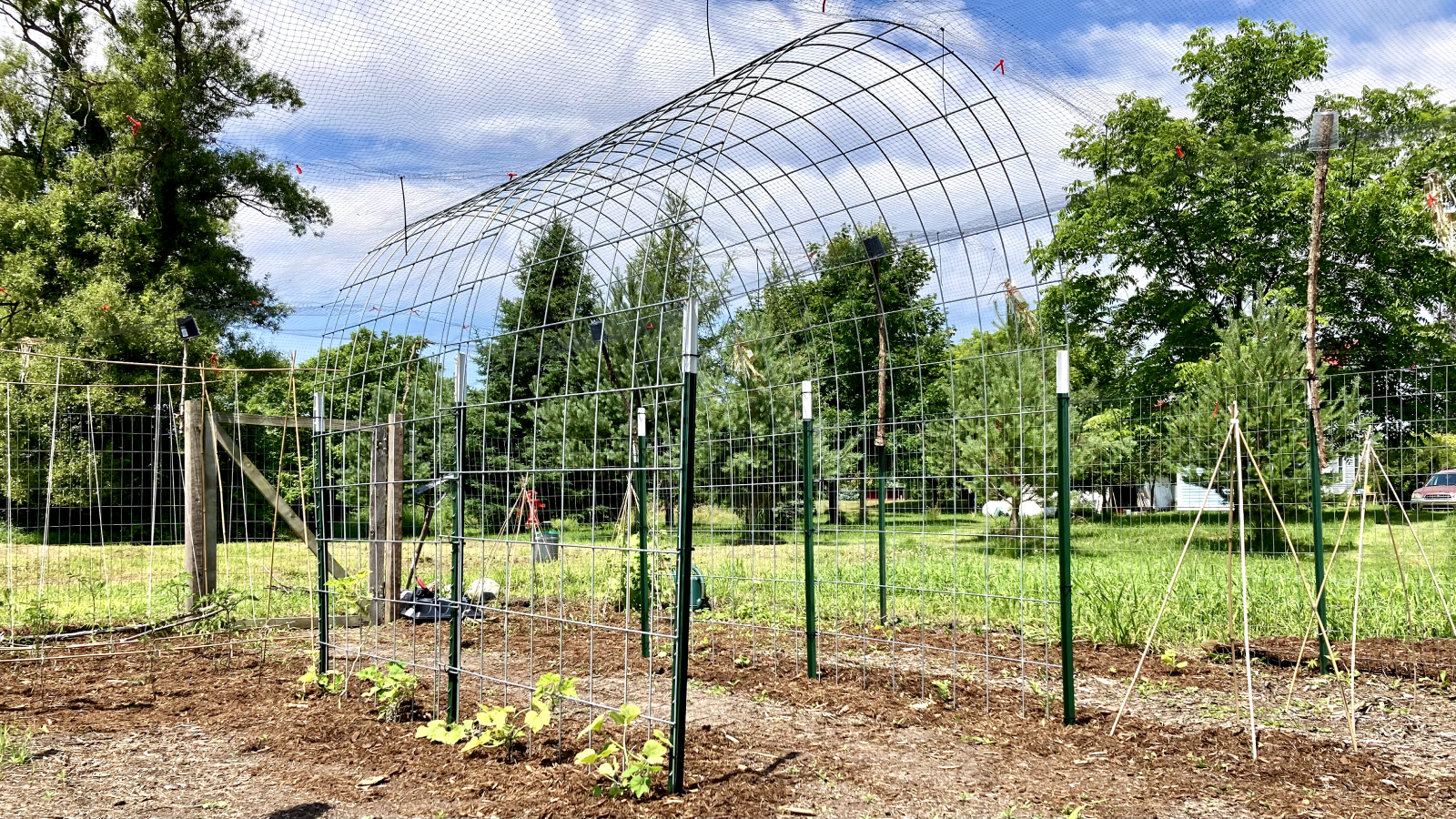

If you’re looking for an easy and inexpensive vegetable trellis idea, then a cattle panel trellis is the answer. This simple DIY garden arch is a great way to grow a vertical vegetable garden that gets plants off the ground and gives you more space to grow. It also helps reduce diseases and other problems caused by overcrowding.
Plus, there’s just something about a lush, vine-covered arch. It can bring a whole garden together! And it creates a lovely shady area to cool off on a hot, summer day.
This simple cattle panel arch costs around $50 dollars to make and takes only a couple hours (or less) to build. Follow the step-by-step guide below to learn how.
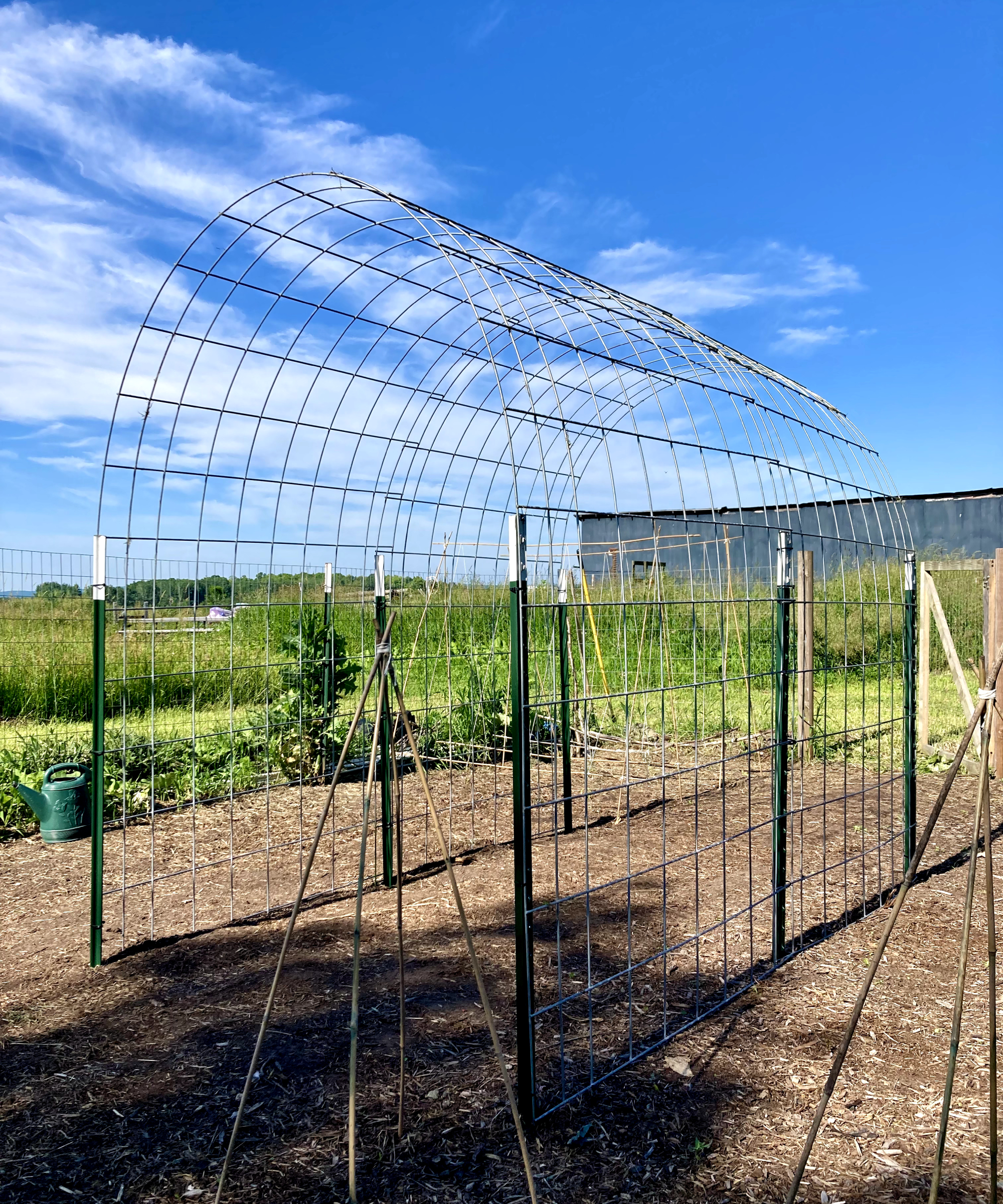
What You Will Need
- 1 cattle panel, 50 in (1.27 m) x 16 ft (4.87 m)
- 4 T-posts, 6 ft (1.82 m)
- 16 zip ties
- Post driver
- Tape measure
- Permanent marker
You can find everything you need for this project from a farm supply store. Some big box hardware stores may carry cattle panels, but it’s worth calling or checking online first before you go.
It’s also beneficial to have a buddy to help you with this project. Theoretically you could do it on your own, but an extra set of hands makes this project much easier.
How to Build a Cattle Panel Trellis
This easy DIY project only takes a few simple steps and an hour or two to complete. Here's how to do it:
1. Choose a Location
Before you can start building your cattle panel trellis, you need to determine where you want to put it. If you have raised beds, you can create an arch that connects two parallel beds. This is a great way to increase your output in a small plot and create a lovely vertical element in your garden.
Gardening tips, videos, info and more delivered right to your inbox!
Sign up for the Gardening Know How newsletter today and receive a free copy of our e-book "How to Grow Delicious Tomatoes".
Check out our Senior Editor’s favorite raised beds from Vego Garden in the Gardening Know How Shop.
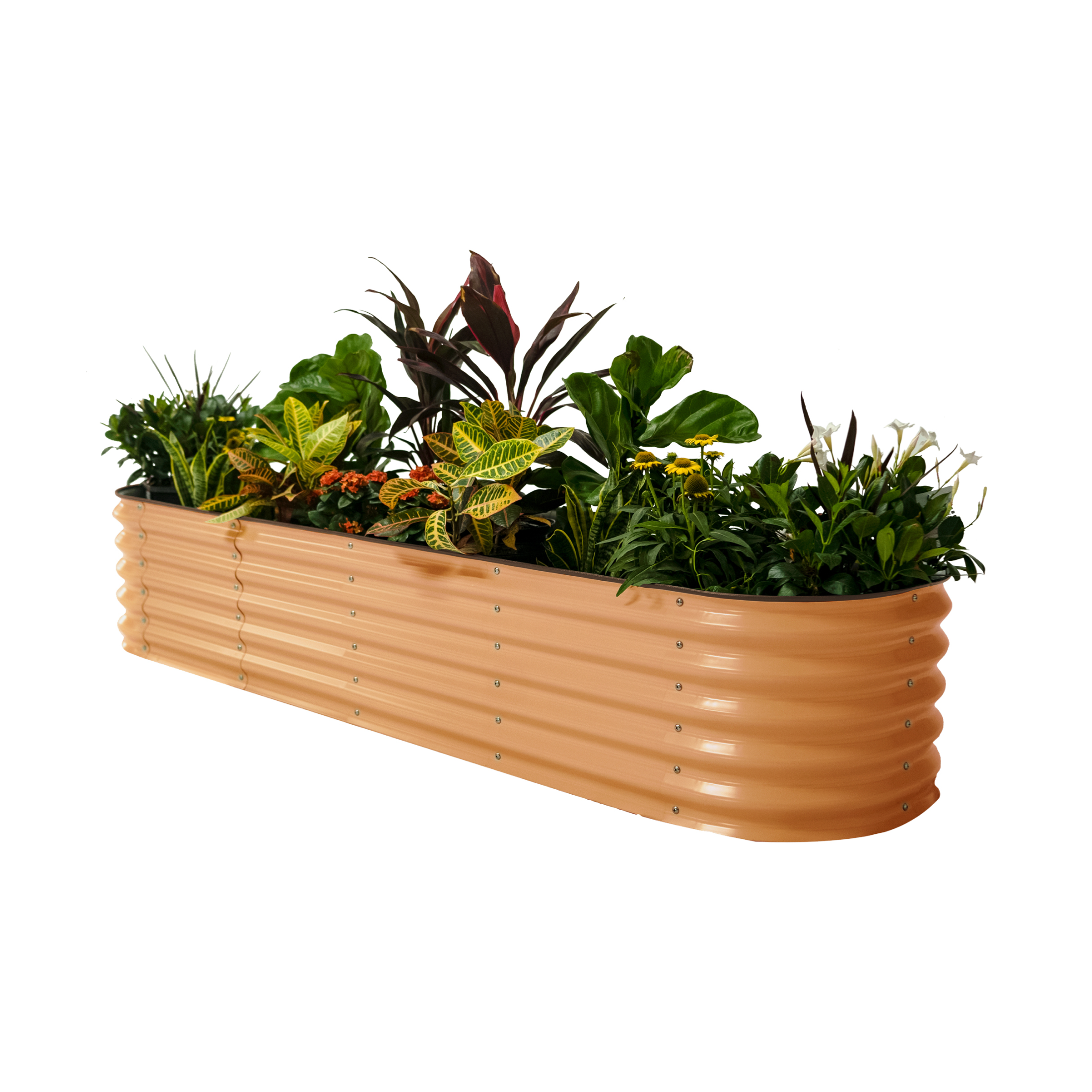
Vego Garden's classic raised bed comes in seven stunning colors that will set off your garden. Buy two to house your very own cattle panel trellis and tons of tasty veggies!
I wanted my trellis to cover the path down the center of my garden. I also wanted to create a bigger trellis that would accommodate more plants. To do this, I essentially built two cattle panel trellises end to end.
These instructions are for a single cattle panel arch, though it’s easy to make a longer tunnel-like trellis by simply purchasing an extra panel and two extra T-posts as you can see in the photos.
Once you’ve gathered your materials and picked the perfect location, you can begin construction.
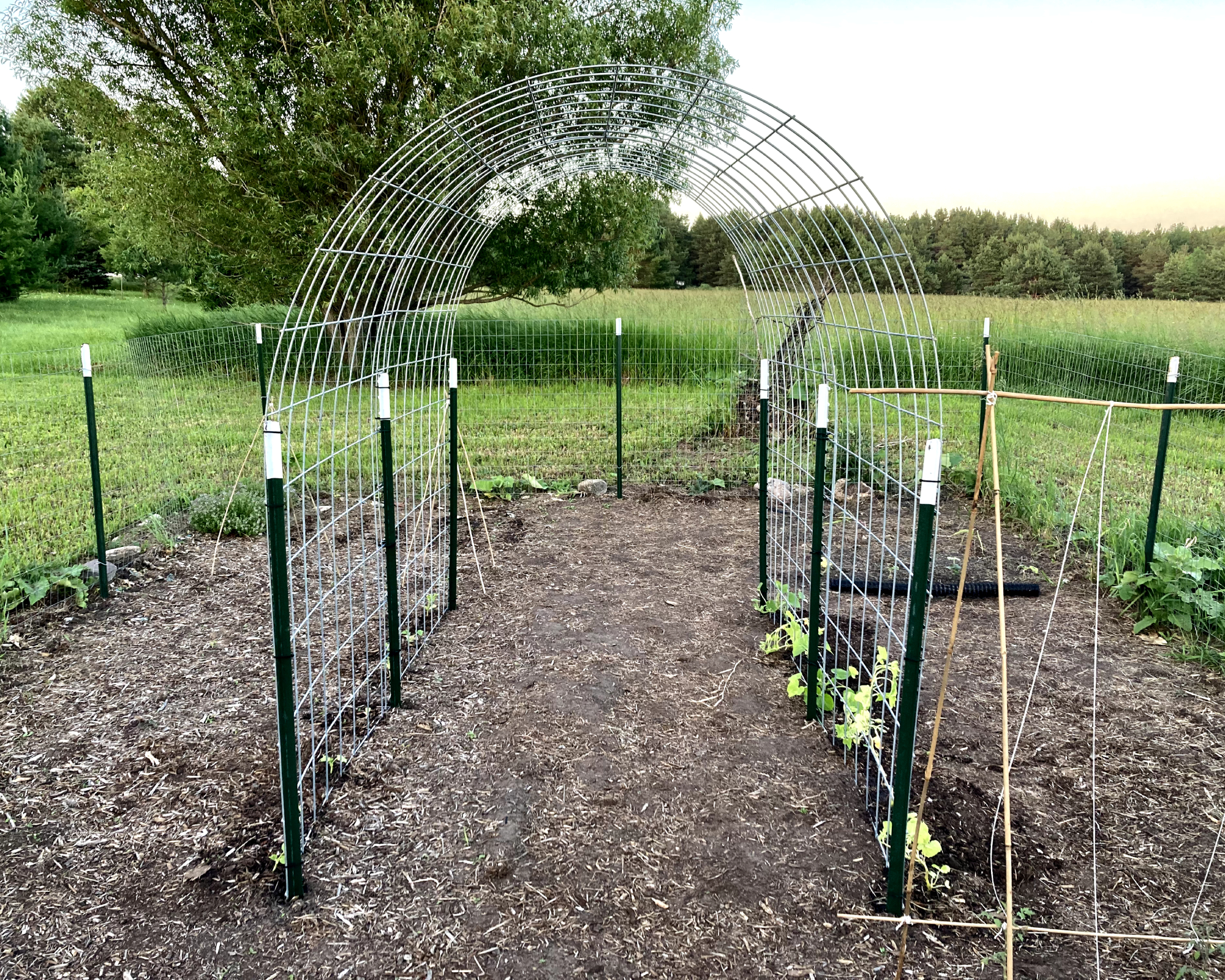
2. Measure
Measure out where you will place the T-posts to hold up the cattle panel arch. For a standard 50 in (1.27 m) x 16 ft (4.87 m) cattle panel, lay out the T-posts in a rectangle that measures 5 ft (1.52 m) by 50 in (1.27 m). This will create an arch that is roughly 6.5 ft (1.98 m) tall.
This is a good height for the average gardener to walk under, tend to the vines, and pick the fruit that grows through the trellis. However, if you are on either the shorter or taller side, you can decrease or increase the distance between the support posts to achieve your desired height.
Use your tape measure to measure out 5 ft (1.52 m) and mark the spots where the posts on the first side of your arch will go. You can use the T-posts to make a divot in the ground that will act as a guide when you bury them.
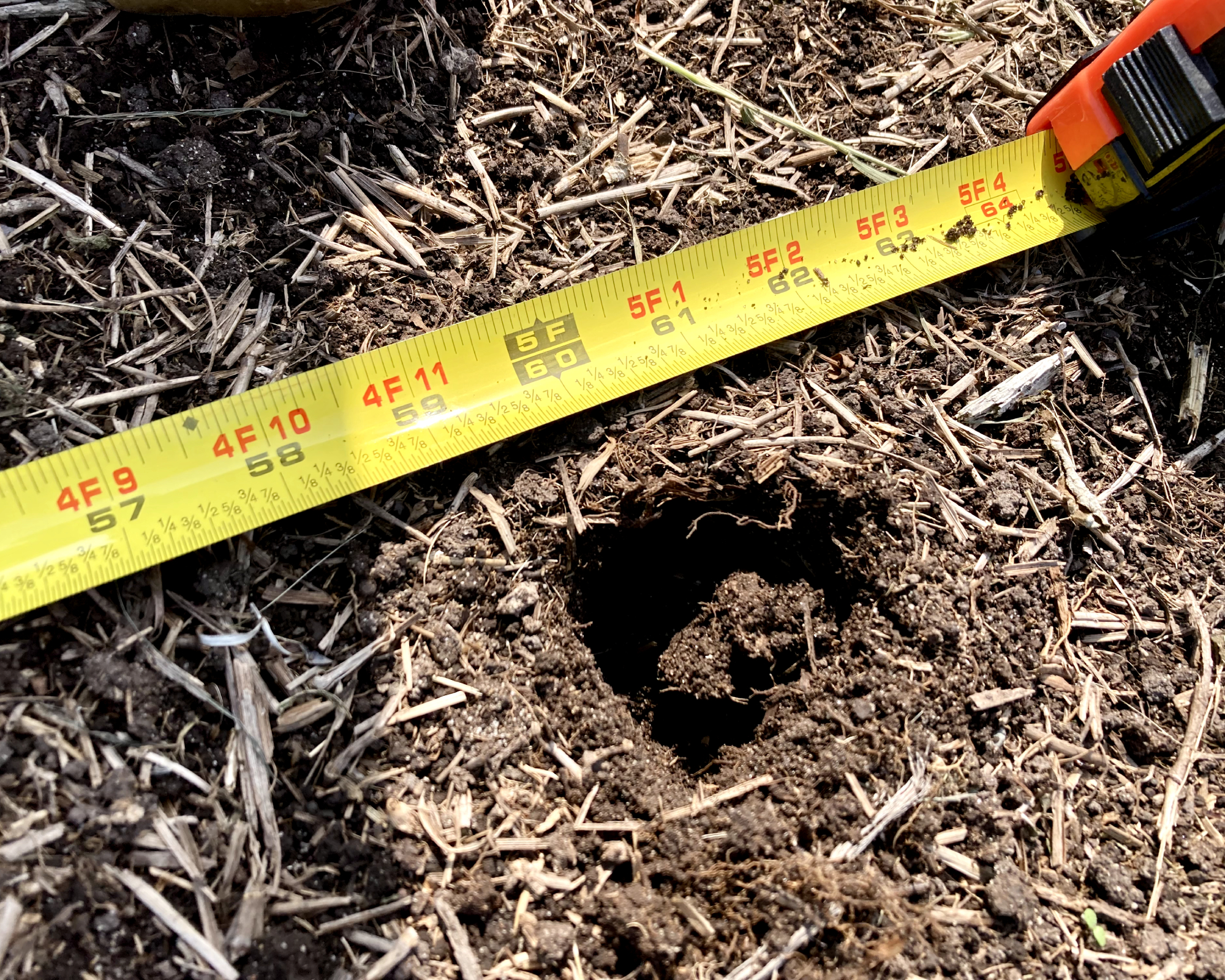
Be sure to measure from the center of one divot to the center of another divot, so the posts line up with the edge of the cattle panel.
Next, measure 50 in (1.27 m) from the divots you just made and mark the spot where the final two T-posts will go to complete the rectangle.
Then measure from the top of each T-post down 4 ft (1.21 m) along its length. Use your permanent marker to draw a line here. This is how deep you need to bury the posts in the next step.
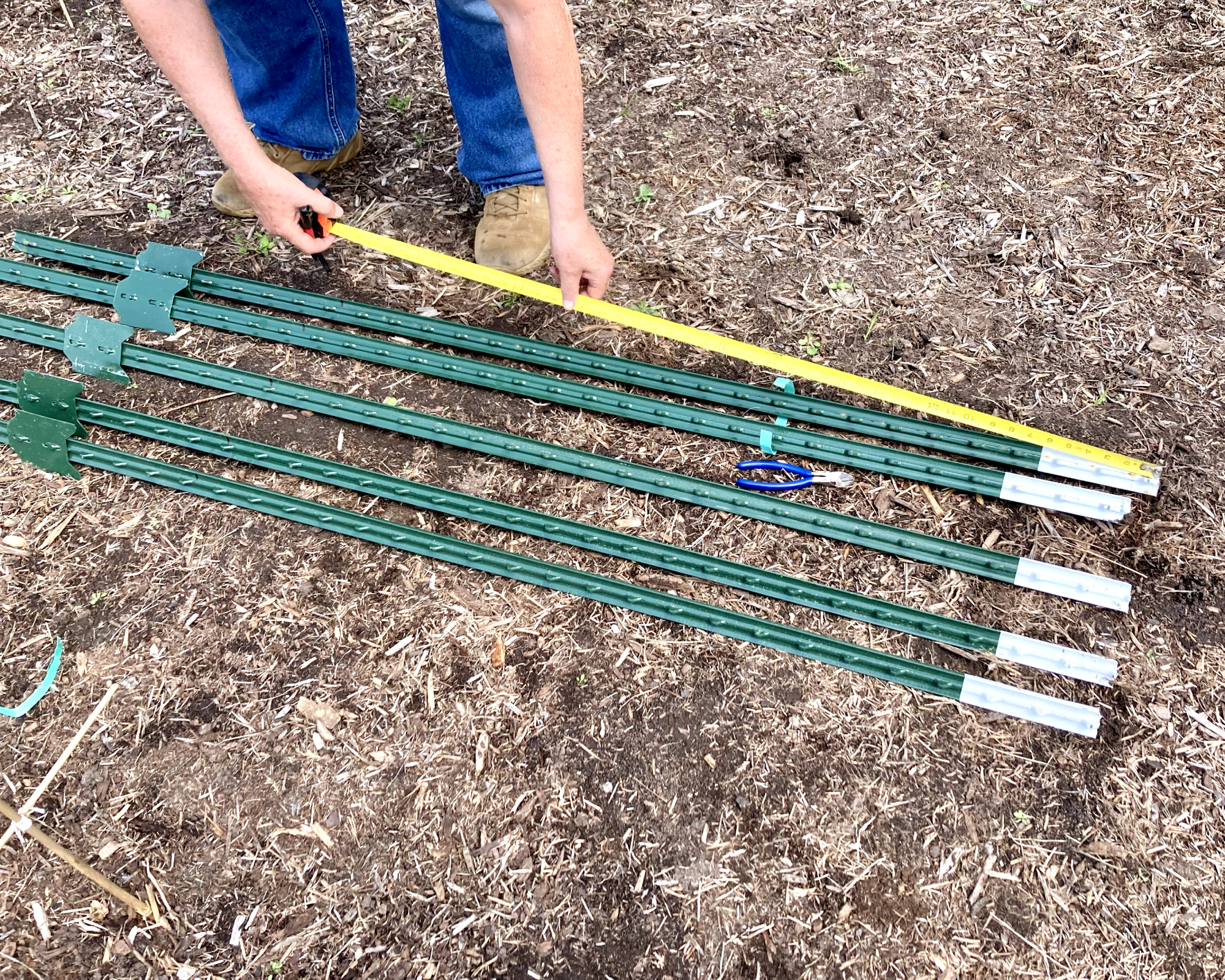
3. Bury Posts
This is the most difficult step in the entire process, as it requires a bit of muscle. Place the bottom of the first T-post in one of the divots you made in the previous step. Face the flat side of the T-post out. This is the side where you will attach the cattle panel.
Hold the post straight, checking from every angle that it is exactly upright. If you have a helper, let them hold the post as you look from every side.
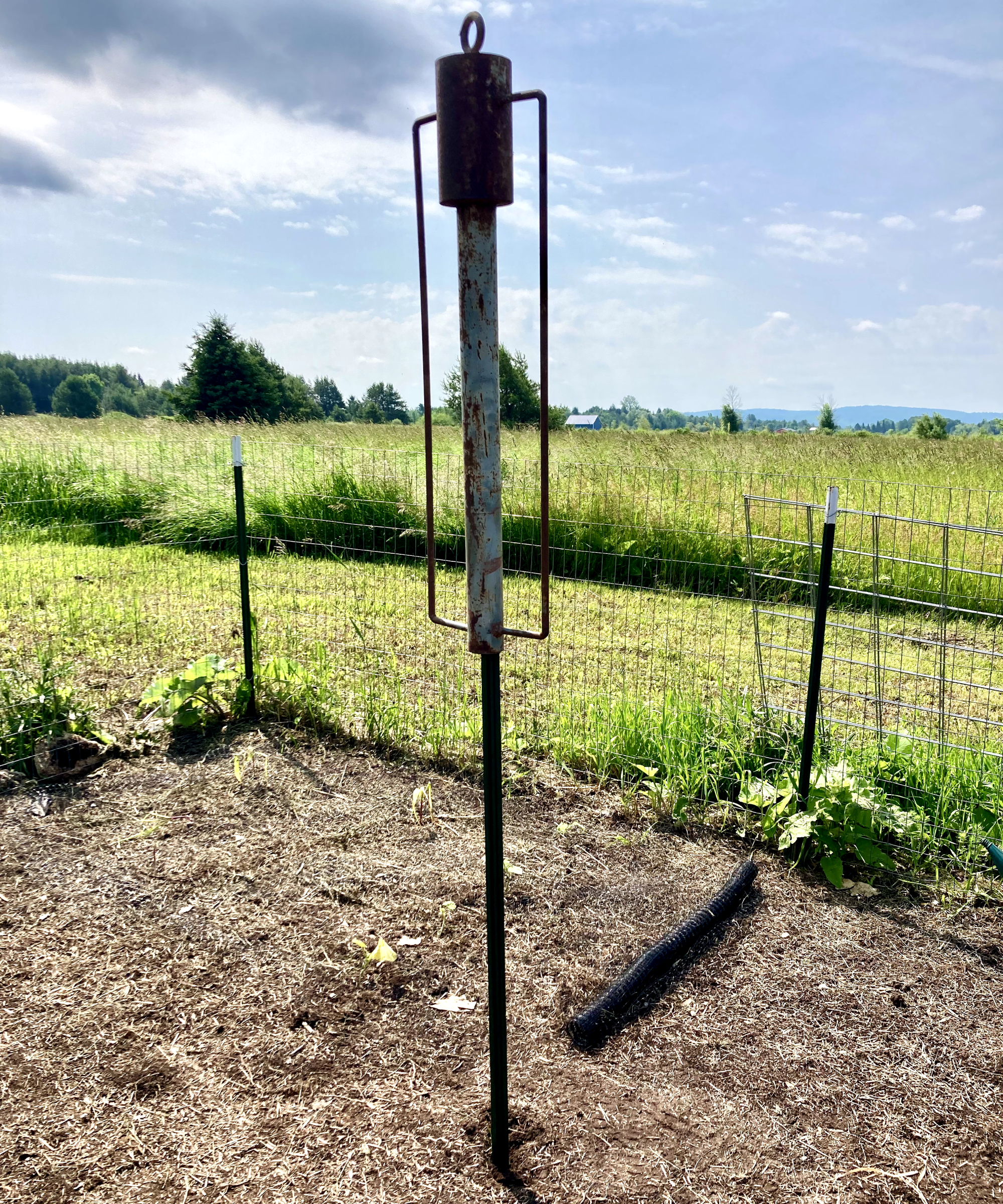
Take your post driver and set it on top of the T-post. Slam the driver down onto the post to bury it in the ground. If your helper is still holding the T-post, make sure their hands and head are out of the way before using the post driver.
Slam the post driver down repeatedly until the line you drew with the permanent marker is level with the ground. Repeat this process with the other T-posts.
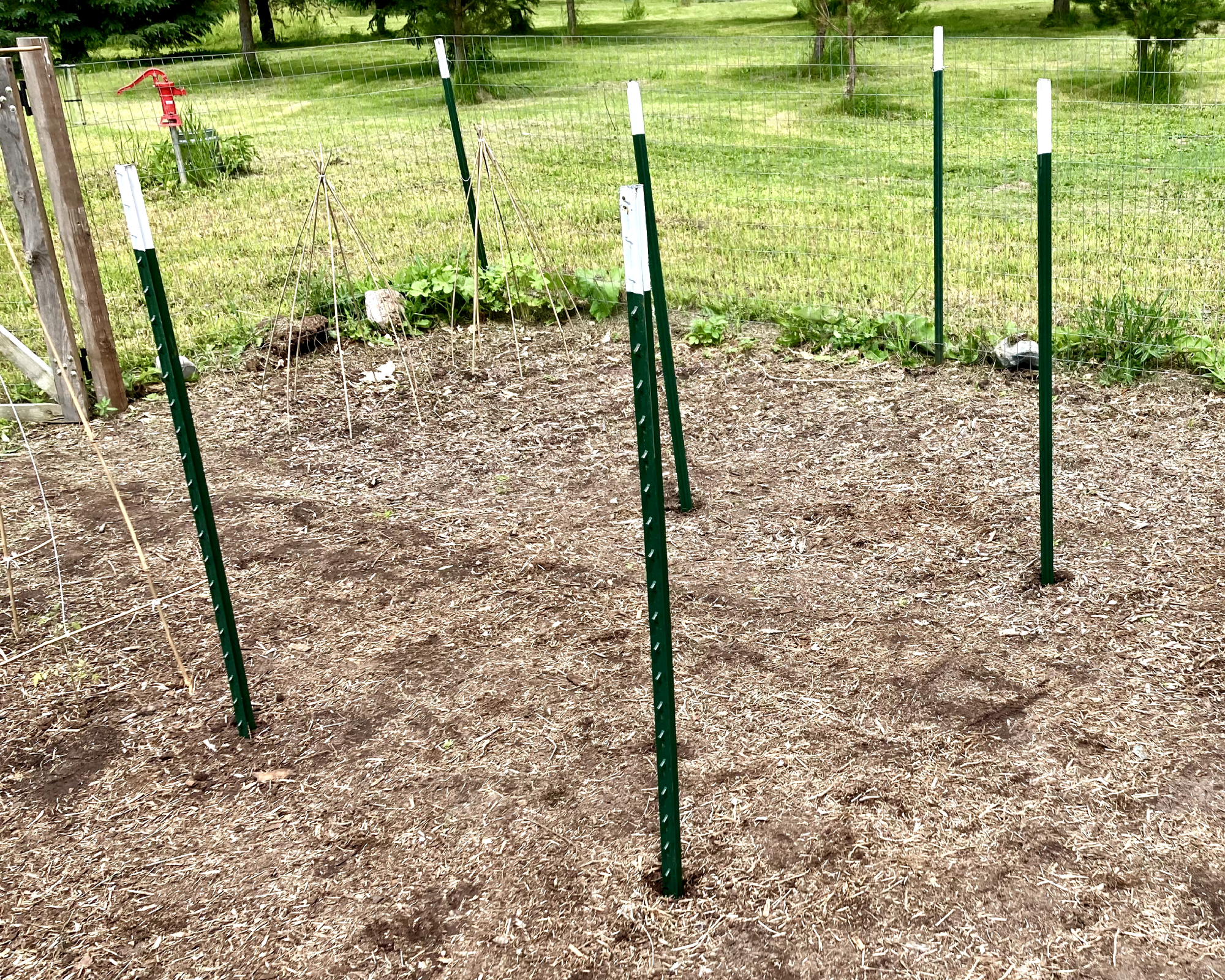
4. Attach Cattle Panel
Once your T-posts are in place, it’s time to attach the cattle panel. This is when you most likely need a helper. Cattle panels are heavy and quite unruly to lift by yourself.
With your buddy’s help, set the cattle panel on the outside (the flat side) of two of the T-posts spaced 50 in (1.27 m) apart with the short end of the panel on the ground.
Starting at the bottom, use the zip ties to affix the cattle panel to the T-posts. Use four zip ties per T-post and space them evenly. You can add more later if you feel like your cattle panel trellis needs more support.
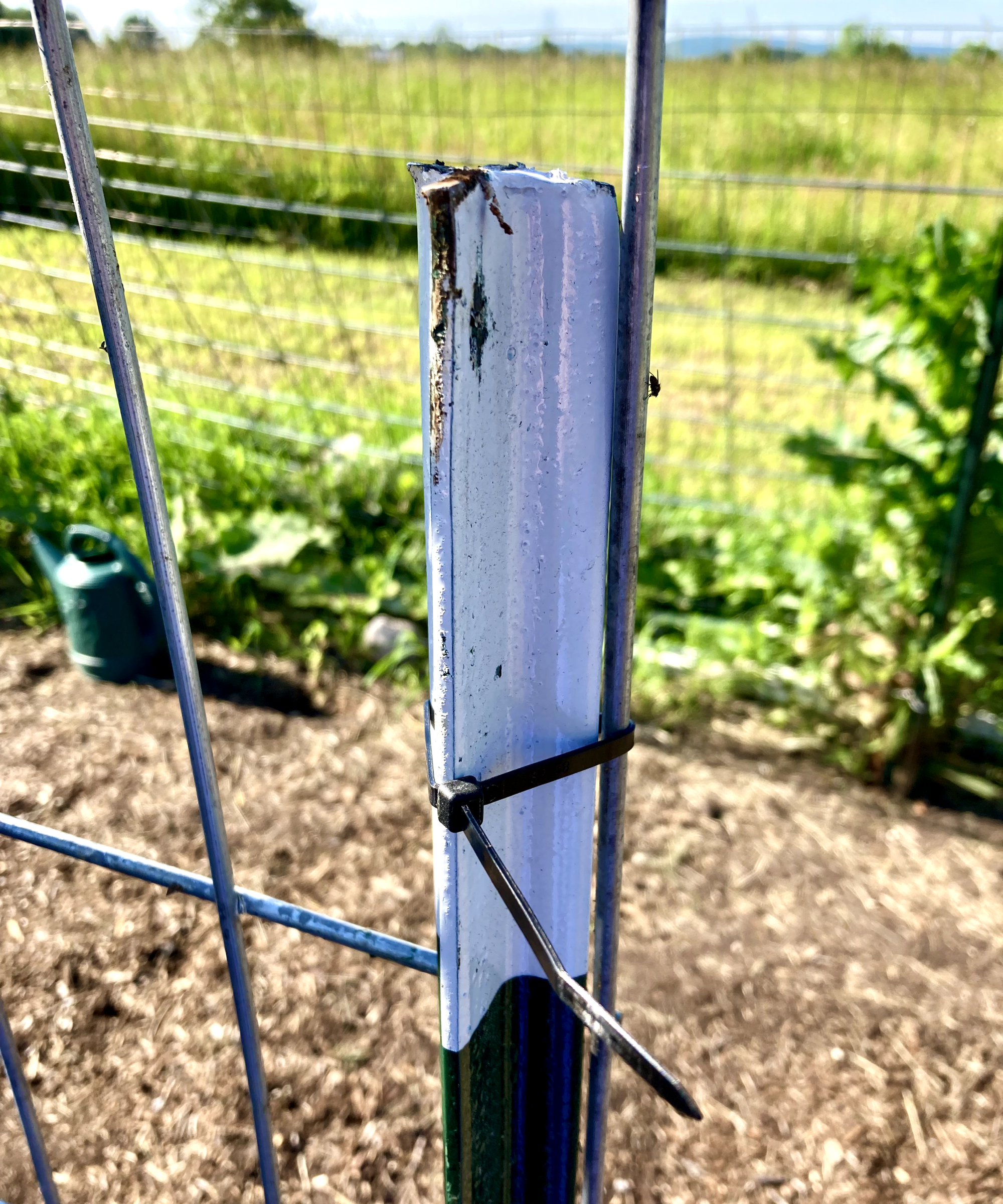
With your buddy’s help, bend the cattle panel over until the opposite end touches the ground on the outside of the other two T-posts. Attach the panel with zip ties.
If you like, you can cut off the tails from the zip ties for a cleaner look. Otherwise, your new cattle panel trellis is complete.
5. Plant
Now is the fun part–it’s time to plant! Follow the spacing guide for your desired plants. You can get away with planting a little closer than you would without a trellis since the vines will grow up and over rather than sprawl around on the ground.
My impulse is always to overplant, but I limited myself to three pumpkins/cucumbers per panel per side. Since I built a longer trellis with two panels, I was able to fit six plants on each side of my cattle panel trellis arch.
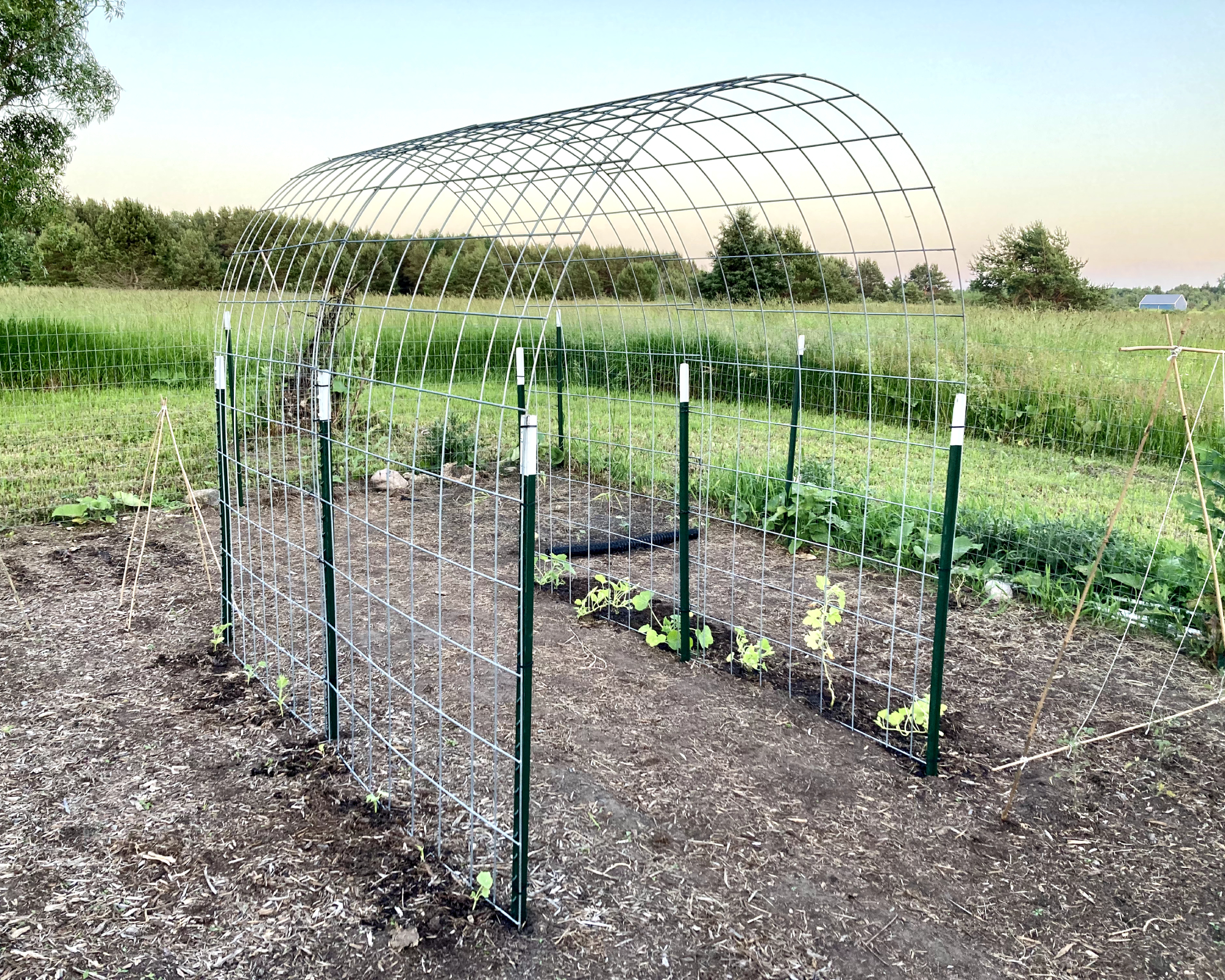
What to Grow on a Cattle Panel Trellis
Many ornamental and edible plants benefit from trellising. I built my cattle panel arch to grow pumpkins and cucumbers, but there are dozens of options to choose from.
You can grow vining flowers like sweet peas or nasturtiums or use your cattle panel as a tomato trellis arch. It’s also fun to combine ornamental and edible plants to create a gorgeous garden that does double-duty.
A popular social media gardening trend is to grow luffa gourds for a homegrown self-care routine. But if you’re looking to go the traditional vegetable garden route, beans, peas, and almost any variety of squash are perfect for this DIY trellis arch.
Frequently Asked Questions
What size are cattle panel trellises?
A cattle panel trellis created with a standard 50 in (1.27 m) x 16 ft (4.87 m) panel measures stands roughly 6.5 ft (1.98 m) tall, 5 ft (1.52 m) wide, and 50 in (1.27 m) deep.
What is the difference between cattle panels and hog panels?
Cattle panels are wider than hog panels. Hog panels typically measure 36 in (.91 m) wide. Cattle panels allow you to grow more plants since they provide more trellis space. Though a hog panel is a good alternative for smaller spaces.
While you're here, check out these products handpicked by the staff at Gardening Know How.
- Got everything you need? Peruse our 10 essential gardening tools.
- Need a raised bed for your trellis? Here are the benefits of metal raised garden beds.
- Want to make the most of your garden? Shop our products with small spaces in mind.
- Sustainable gardening is more important than ever. Shop sustainable plants and do your part.
This article features products available from third-party vendors on the Gardening Know How Shop.

Laura Walters is a Content Editor who joined Gardening Know How in 2021. With a BFA in Electronic Media from the University of Cincinnati, a certificate in Writing for Television from UCLA, and a background in documentary filmmaking and local news, Laura loves providing gardeners with all the know how they need to succeed, in an easy and entertaining format. Laura lives in Southwest Ohio, where she's been gardening for ten years, and she spends her summers on a lake in Northern Michigan. It’s hard to leave her perennial garden at home, but she has a rustic (aka overcrowded) vegetable patch on a piece of land up north. She never thought when she was growing vegetables in her college dorm room, that one day she would get paid to read and write about her favorite hobby.